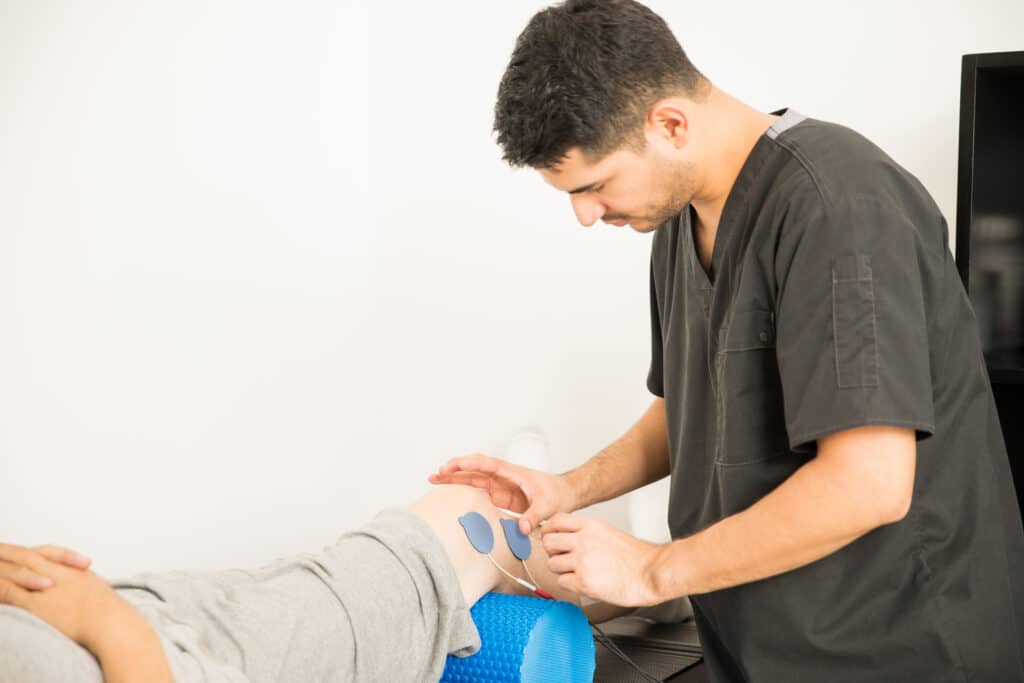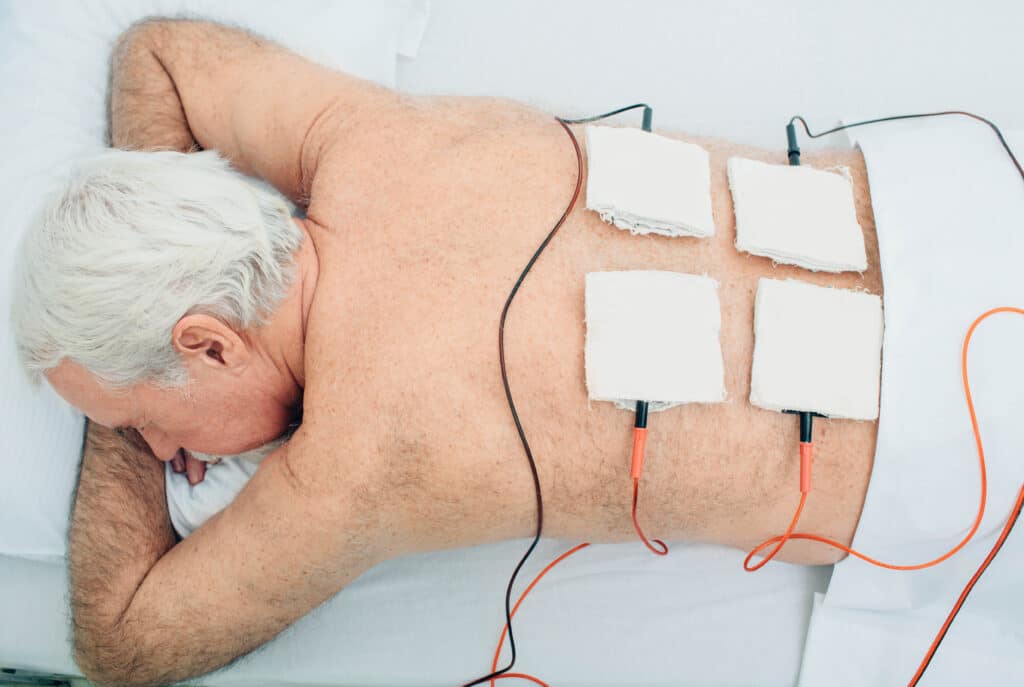Pain is an unfortunate reality that can significantly impact many older adults’ lives. Fortunately, modern medicine offers many innovative approaches to help you deal with pain or muscular problems. When it comes to readily available treatment options for pain management and tools to improve function, electrical stimulation therapy is one of the most unique and exciting options.
- What Is Electrical Stimulation Therapy?
- Types of Electrical Stimulation Therapy
- Examples of Conditions Commonly Treated with E-Stim
- What Are the Advantages of Electrical Stimulation Therapy?
- What Are the Risks and Limitations of Electrical Stimulation Therapy?
- Preparing for Your Treatment
- Key Takeaways
- FAQs
You may have heard about—or even used this type of therapy with your PT without knowing much about it. But what is it, and how exactly does electrical stimulation therapy work?
In this article, we’ll dive into what electrical stimulation therapy—also known as E-Stim—is, how it’s used to treat various conditions, and some tips you can follow to stay safe and maximize benefits when using this treatment approach.
What Is Electrical Stimulation Therapy?
Your nerves naturally carry tiny electrical pulses from your brain through your body and back again to help every part of you function. Whether you’re touching your fingers together, walking, or picking up the telephone, your body needs these electrical messages from your brain to move.
With age, illness, or injury, sometimes, these pulses may not be able to reach their destination effectively. Electrical stimulation therapy uses electrical currents to stimulate muscles or nerves that may have become less functional.
These electrical currents are delivered through small sticky pads called electrodes, which are attached to the skin or, in some cases, implanted in the body. The electrodes are connected to a device that controls the electrical stimulation’s intensity, frequency, and duration to help your tissues move, recover, and grow.
How is E-Stim Beneficial for Me?
This treatment helps heal by using electrical currents that your nerves might not otherwise be able to generate to treat or manage various conditions.
Electrical stimulation therapy isn’t just about sending electrical pulses into the body. It’s a precise therapeutic tool that holds promise for various health challenges, especially for older people.
The treatment can affect the body differently depending on the type being used. Some of the most common purposes for E-Stim include:
- Muscle contraction: Electrical stimulation can cause the muscles to contract or relax, improving muscle strength, endurance, or coordination. When an electrical current targets muscles, it causes them to contract, mimicking what happens during physical activity. This can be especially beneficial for muscles that have become weak or atrophied.
- Pain relief: Electrical stimulation therapy can alter how nerves convey signals, especially pain signals. It can block or reduce the transmission of pain signals from the nerves to the brain, decreasing the sensation of pain and increasing pain tolerance.
- Wound healing: Electrical stimulation can speed up wound healing by bringing needed oxygen and blood flow to areas in need.
While many of my patients request electrical stimulation therapy primarily for pain relief, I have helped many older adults learn to use electrical stimulation therapy for various other conditions. Different devices and techniques can be used depending on the therapy’s purpose.
Types of Electrical Stimulation Therapy

The term “electrical stimulation” is a broad umbrella. Different types of electrical stimulation therapy are used for different purposes and benefits.
Some of the most common types that we typically use in the clinic or at home are:
- Transcutaneous Electrical Nerve Stimulation (TENS): TENS is a type of electrical stimulation therapy that uses low-voltage currents to stimulate sensory nerves to help relieve pain. TENS is usually applied to the skin over or near the painful area using adhesive electrodes. Many patients use TENS for acute or chronic pain conditions, such as back pain, arthritis, and post-surgical pain.
- Interferential Current (IFC): This electrical stimulation therapy penetrates deeper into the tissues. Using four adhesive electrodes, IFC is usually applied to the skin over or near the affected area. IFC is generally used for pain relief and muscle relaxation.
- Neuromuscular Electrical Stimulation (NMES): This electrical stimulation therapy uses medium-frequency currents to stimulate motor nerves to cause muscle contraction in a specific pattern or sequence. NMES is often used for functional restoration, spasticity management, gait training, and swallowing rehabilitation.
While the names of these devices might seem intimidating, they have all proven safe and effective for these purposes.
Each type of electrical stimulation therapy has advantages and disadvantages, depending on your specific goals. Your physical therapist can help you determine which type is best for you and how to use it effectively.
Examples of Conditions Commonly Treated with E-Stim

Electrical stimulation therapy can treat various medical conditions that affect the body’s muscles, nerves, or other tissues. Some of the most common examples that I see are:
Back Pain
Back pain is an all-too-common condition that affects most older adults at some point. It can be caused by muscle injury, overuse, inflammation, or spinal compression. Electrical stimulation therapy, such as TENS or IFC, can help relieve back pain by blocking or reducing nerve pain signals to the brain. In my professional practice, this is one of the most common uses for electrical stimulation therapy.
Muscle Weakness
Muscle weakness is a condition that occurs when muscles lose their strength due to neurological injury or muscle atrophy, which is the loss of muscle mass and tone due to disuse. Electrical stimulation therapy, such as NMES, can help improve muscle weakness by assisting the muscles to contract, which can increase muscle function.
Overactive Bladder
Overactive bladder is a condition that occurs when the bladder muscles contract involuntarily or too frequently, causing symptoms such as urinary urgency and leakage. Electrical stimulation therapy can help improve bladder control by stimulating muscles or nerves controlling the bladder, which can reduce these problems.
Stroke Rehabilitation
Stroke rehabilitation revolves around restoring function and quality of life after experiencing a stroke. Electrical stimulation therapy can help improve stroke recovery by reducing muscle spasticity and retraining movement patterns. It’s also popular in stroke rehabilitation clinics and care facilities.
Remember that electrical stimulation therapy is not the best treatment for every condition. For this reason, I always remind my patients to consult their doctor or physical therapist before starting electrical stimulation therapy to determine if it suits them, what type of device they should use, and how to be as safe as possible.
What Are the Advantages of Electrical Stimulation Therapy?
Electrical stimulation therapy can offer many advantages for people who suffer from various medical conditions that affect their muscles, nerves, or tissues.
Here are some of the benefits to consider with E-stim:
It’s non-invasive and relatively painless.
Electrical stimulation therapy does not require surgery, injections, or medications. In most cases, it only requires applying electrodes to the skin. While electrical stimulation is usually not painful, it can create an uncomfortable tingling or buzzing sensation.
Some of my patients find these sensations relaxing, while others do not tolerate it as well. Like most treatments, every body will react differently.
It can be customized.
Electrical stimulation therapy is highly customizable to suit your individual needs and preferences. Your physical therapist can control the device that delivers the electrical stimulation.
If you’re trained for safe use, you can even operate it. The electrodes can also be placed in different locations to target specific muscles or nerves, giving you many treatment options.
It can be used alone or in combination with other physical therapy methods.
Electrical stimulation therapy can be used as a standalone treatment but is often combined with other physical therapy interventions such as exercise and manual therapy.
Many patients appreciate electrical stimulation therapy because it can help prepare muscles or nerves for other interventions by warming them up, relaxing them, or keeping pain levels down.
What Are the Risks and Limitations of Electrical Stimulation Therapy?
While electrical stimulation therapy is generally safe, it may not be helpful in every scenario. Some of the potential risks and limitations include:
It may not always be a safe treatment option.
E-stim therapy may not be recommended for people who have certain medical conditions or devices that may interfere with or be affected by the electrical currents, such as:
- Pacemakers or implantable cardioverter defibrillators (ICDs) regulate the heart rhythm and prevent cardiac arrest. Electrical stimulation therapy may cause them to malfunction.
- Metal implants may be inserted into the body to replace or support a damaged bone or joint, such as pins, screws, plates, or rods. Electrical stimulation therapy may cause heating, corrosion, or migration of the metal implants.
- Electrical stimulation therapy may irritate and worsen wounds, infections, rashes, or burns if the electrodes are applied to damaged or sensitive skin.
Like I tell all of my patients, you should consult your doctor or physical therapist before starting electrical stimulation therapy to ensure you’re a good candidate.
A licensed medical professional can help you determine if electrical stimulation therapy is safe and appropriate for your needs and any precautions you must take before, during, or after treatment.
It may not be the best option for you.
Electrical stimulation therapy may not be a good fit for some people. Some of the factors that can affect its usefulness are:
- Different people will respond differently to electrical stimulation therapy depending on their body type, pain tolerance, sensitivity, and preference. Some of my patients find electrical stimulation therapy helpful, while others find it ineffective or unpleasant.
- Conditions may vary in their severity, duration, and cause. Some conditions may respond well to electrical stimulation therapy, while others may not. For example, electrical stimulation therapy may be more effective for acute pain than chronic pain or nerve pain than muscle pain.
- The type of electrical stimulation therapy determines its effectiveness. Some types and parameters may be more suitable for specific conditions or goals. The suggested E-stim type may not work for you or your condition.
Results are typically temporary.
E-stim typically requires frequent sessions and maintenance to achieve meaningful results, and they’re often temporary. This means that while it helps you feel better in the short term, you may not get better for an extended period.
Most patients use electrical stimulation therapy to increase their participation or adherence to other treatment approaches, like exercise, to see long-term results. This way, you can benefit the most from your electrical stimulation therapy while focusing on treatments that tend to get longer-lasting results.
Preparing for Your Treatment
If you have decided to try electrical stimulation therapy, here are some practical tips on what to do before, during, and after electrical stimulation therapy.
Before Treatment
- Consult with your doctor or physical therapist to help you determine if electrical stimulation therapy is right for you and what type of device you need. They can also explain how electrical stimulation therapy works, what to expect, and what to avoid.
- Get a prescription from your doctor or physical therapist for an electrical stimulation device, or have it covered by your insurance. You should also check with your insurance company about the coverage and costs of electrical stimulation therapy.
- Choose an electrical stimulation device that suits your needs and preferences. You can buy or rent a device from a medical supply store, online, or through your physical therapist. You should also get the necessary accessories, such as electrodes, batteries, wires, and chargers (in my experience, these almost always come with the device).
- Read the user manual and follow the device’s instructions carefully. It is often helpful if my clients bring their devices into the clinic so we can review them together and practice using them for a specific purpose.
During Your Session
- Clean and dry your skin before applying the electrodes. You should also avoid using lotions, creams, oils, or alcohol on your skin as they may interfere with the electrical stimulation or cause skin irritation. Many of my patients forget about this step, so schedule your electrical stimulation therapy around using lotions or topical medications as best as possible.
- Apply the electrodes to your skin over or near the target muscles or nerves. Ensure that the electrodes are firmly attached and that there are no air bubbles or gaps between them and your skin.
- Turn on the device, then adjust the settings according to your comfort level and goals. Start with a low intensity and gradually increase it until you feel a tingling, buzzing, or tapping sensation. You should not feel any pain.
- Monitor your response during and after each session of electrical stimulation therapy. Pay attention to any changes in your pain level and note any side effects or problems you experience, such as skin irritation, muscle fatigue, or device malfunction.
After Your Session
- Turn off the device and disconnect the electrodes from your skin.
- Check your skin for any signs of irritation or burns. After treatment, you can also moisturize your skin with a mild lotion or cream if it feels dry or tight.
- Report any adverse effects or concerns to your physical therapist immediately. If a patient of mine has problems during their first session, there is almost always a simple solution to stop the problem from happening in the future.
Key Takeaways
- Electrical Stimulation Therapy (E-Stim) addresses pain and improves muscle function.
- E-Stim uses electrodes to stimulate weak muscles or nerves.
- Popular E-Stim types are TENS for pain relief, IFC for muscle relaxation, and NMES for muscle rehab.
- It commonly treats back pain, muscle weakness, and overactive bladder and aids in post-stroke rehabilitation.
- E-Stim offers non-invasive, customizable treatments.
- It’s not suitable for those with pacemakers or metal implants.
- Effectiveness can vary, and results are often temporary.
If you want to try electrical stimulation therapy, speak to your doctor or physical therapist to determine if it is right for you.
FAQs
When can you expect results from electrical stimulation?
Results from electrical stimulation can vary by individual and the condition being treated. Some people experience immediate relief after a session, while others may need multiple treatments to notice a significant difference.
How does E-Stim compare to other pain treatments?
E-Stim is non-invasive and focuses on stimulating nerves or muscles for pain relief or functional improvement. It can be effective for certain conditions but might be combined with other therapies like exercise or manual therapy for optimal results.
Are there conditions where E-Stim works best or should be avoided?
E-Stim is particularly effective for conditions like muscle weakness or rehabilitation after a stroke. However, it should be avoided by those with certain devices like pacemakers, or on areas with skin infections, wounds, or certain metal implants.
Are there long-term effects from using E-Stim?
When used correctly and under professional guidance, E-Stim is generally considered safe with no known long-term adverse effects. However, it’s always important to monitor and discuss any concerns with a healthcare professional.
Is E-Stim more costly than other treatments?
The cost of E-Stim can vary based on location, equipment, and frequency of sessions. In some cases, insurance might cover portions of the treatment. It’s essential to compare it with other treatments and consider the potential benefits and results for the cost.
References
- Doucet, B. M., Lam, A., & Griffin, L. (2012). Neuromuscular electrical stimulation for skeletal muscle function. The Yale Journal of Biology and Medicine, 85(2), 201–215.
- Miao Q, Qiang JH, Jin YL. Effectiveness of percutaneous neuromuscular electrical stimulation for neck pain relief in patients with cervical spondylosis. Medicine (Baltimore). 2018 Jun;97(26):e11080. doi: 10.1097/MD.0000000000011080. PMID: 29952946; PMCID: PMC6039622.
- Jauregui JJ, Cherian JJ, Gwam CU, Chughtai M, Mistry JB, Elmallah RK, Harwin SF, Bhave A, Mont MA. A Meta-Analysis of Transcutaneous Electrical Nerve Stimulation for Chronic Low Back Pain. Surg Technol Int. 2016 Apr;28:296-302. PMID: 27042787.
- Alamer A, Melese H, Nigussie F. Effectiveness of Neuromuscular Electrical Stimulation on Post-Stroke Dysphagia: A Systematic Review of Randomized Controlled Trials. Clin Interv Aging. 2020 Sep 3;15:1521-1531. doi: 10.2147/CIA.S262596. PMID: 32943855; PMCID: PMC7481288.




